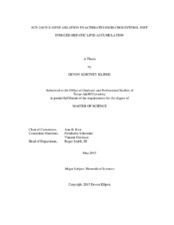| dc.description.abstract | While a high-cholesterol diet has previously been shown to induce hepatic lipid accumulation in mice, the role of the intracellular cholesterol binding/transport proteins sterol carrier protein-2/sterol carrier protein-x (SCP-2/SCP-x) in this phenotype is unknown. Therefore, the impact of SCP-2/SCP-x gene ablation (double knockout, DKO) on hepatic and serum lipids as well as hepatic expression of proteins in cholesterol homeostasis was examined in mice fed control- and high-cholesterol diets.
Cryopreserved liver, serum, and bile samples from DKO and wild-type, C57BL/6NCr mice which previously underwent a 29 day diet trial on a control- and high-cholesterol diet were utilized along with phenotypic and food consumption data gathered during the study. Liver, serum and biliary lipids were quantified using standard commercially available diagnostic kits. Hepatic mRNA levels of select genes and expression levels of select hepatic proteins involved in lipid metabolism were quantified via qRT-PCR and standard western blotting techniques.
The high-cholesterol diet alone had no impact on food consumption or body weight gain in WT mice, but elicited hepatic accumulation of free and esterified cholesterol. High-cholesterol diet decreased hepatic expression of the SREBP2 target gene product HMGCR in females, but not other target gene proteins (SR-B1, LDL-R, cHMGCS) in either sex. Concomitantly, high-cholesterol also elicited hepatic glyceride accumulation, especially triglyceride, which was associated with increased hepatic SREBP1 protein and SREBP1 lipogenic target gene expression (Acc1, Fas).
While the DKO did not alter food consumption, a significant decrease in BW gain was appreciated in both high-cholesterol diet and control-fed mice. The DKO also induced hepatic lipid accumulation in control-fed mice, especially of cholesteryl esters and glycerides, which was associated with: i) loss of SCP-2; ii) concomitant upregulation of L-FABP; and/or iii) increased protein levels of SREBP1 and SREBP2. Finally, DKO exacerbated the high-cholesterol diet-induced hepatic cholesterol and glyceride accumulation, but without further altering levels of SREBP2 target genes. Hepatic lipid secretion was impaired due to loss of SCP-2 and reducing Apo B, L-FABP and MTP protein expression. These findings suggested a potential role for SCP-2 in regulating hepatic accumulation of SREBP1 and SREBP2 proteins consistent with the ability of SCP-2 to facilitate intracellular cholesterol trafficking to endoplasmic reticulum from which SREBPs are derived. | en |


